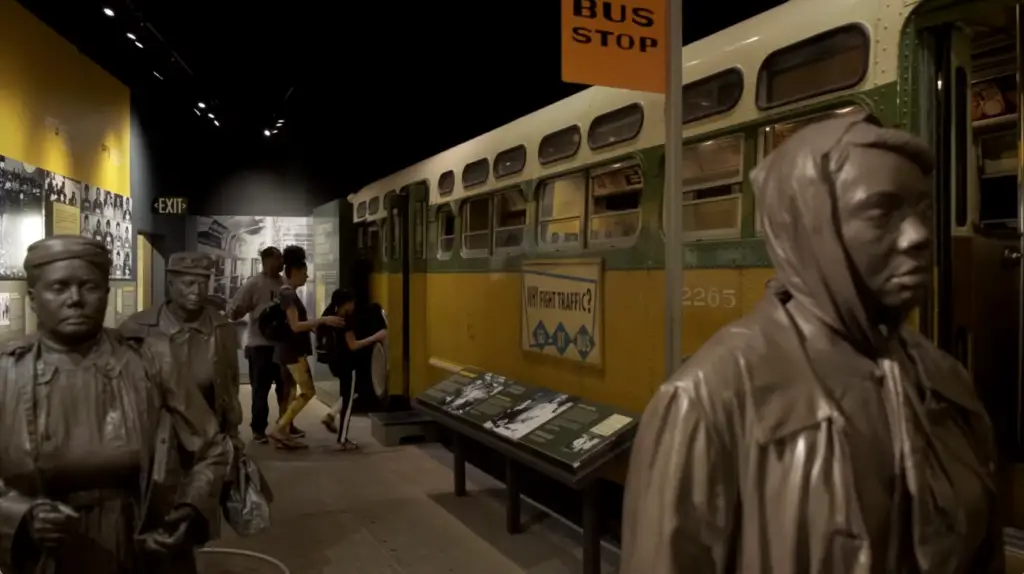Nestled in the heart of Memphis, Tennessee, the National Civil Rights Museum stands as a powerful testament to the indomitable spirit of those who championed the cause of equality and justice during the American Civil Rights Movement. Situated at the historic Lorraine Motel, where the tragic assassination of Dr. Martin Luther King Jr. took place in 1968, this museum is a living chronicle of the struggles, sacrifices, and triumphs that defined a pivotal era in the nation’s history.
As visitors step through the museum’s doors, they embark on a poignant journey that transcends time, weaving through the threads of America’s complex past—from the shackles of slavery to the triumphs of the Civil Rights Movement and beyond. The National Civil Rights Museum is not merely a repository of artifacts; it is a living narrative that invites contemplation and challenges us to confront the stark realities of the fight for justice.
In this exploration, we will delve into the key features, exhibits, educational initiatives, and visitor experience that make the National Civil Rights Museum an indispensable pilgrimage for those seeking a profound understanding of the country’s ongoing pursuit of civil rights. Join us as we navigate the corridors of history, discovering the museum’s impactful displays, thought-provoking installations, and the living legacy it imparts to visitors from all walks of life.
Table of Contents
Mission
At the core of the National Civil Rights Museum’s existence lies a profound and unwavering mission: to educate, inspire, and foster a deeper understanding of the American Civil Rights Movement. With the Lorraine Motel as its poignant backdrop, the museum is dedicated to preserving the legacy of those who courageously fought against racial injustice and segregation.
The mission extends beyond the preservation of historical artifacts and documents; it is a commitment to engage visitors in a transformative experience. By meticulously curating exhibits that traverse the complex landscape of America’s civil rights journey, the museum seeks to evoke empathy, provoke thought, and instill a sense of responsibility for the ongoing struggle towards a more just and equitable society.
Every facet of the National Civil Rights Museum is designed to uphold this mission. From the preserved rooms at the Lorraine Motel, frozen in time to immortalize the day Dr. Martin Luther King Jr. stood on its balcony, to the modern Legacy Building that explores contemporary challenges in the fight for civil rights, each element contributes to the overarching goal of creating an immersive and educational environment.
The museum’s mission extends to educational programs that reach schools, colleges, and community groups. By offering guided tours, workshops, and outreach initiatives, the National Civil Rights Museum actively shapes the narrative of civil rights, fostering a new generation of advocates committed to social justice and equality.
In essence, the museum’s mission is a beacon of enlightenment and empowerment. It seeks not only to tell the stories of the past but to inspire action in the present and future. The National Civil Rights Museum stands as a living testament to the belief that understanding our history is essential for forging a path toward a more inclusive and equitable tomorrow.
Exhibits
The National Civil Rights Museum unfolds its compelling narrative through a series of meticulously curated exhibits, each a poignant chapter in the ongoing story of America’s struggle for civil rights. These exhibits serve as immersive portals, transporting visitors through pivotal moments in history and shedding light on the individuals whose resilience and courage shaped a nation.
1. Lorraine Motel: The journey begins at the Lorraine Motel, frozen in time to preserve the somber atmosphere of April 4, 1968. The preserved rooms, including the balcony where Dr. Martin Luther King Jr. stood, provide an intimate glimpse into the tragic events that unfolded and symbolize the sacrifices made in the pursuit of justice. (Affiliate Link to TripAdvisor)
2. From Slavery to Civil Rights: This foundational exhibit traces the roots of the struggle, exploring the era of slavery and the arduous path toward emancipation. It sets the stage for understanding the historical context that gave rise to the Civil Rights Movement.
3. The Montgomery Bus Boycott: Step into the shoes of those who participated in the Montgomery Bus Boycott, a pivotal moment ignited by Rosa Parks’ refusal to give up her bus seat. Interactive displays and multimedia presentations bring to life the determination and unity that fueled this early spark in the fight against segregation.
4. March to Freedom: Immerse yourself in the iconic events that defined the Civil Rights Movement, from the March on Washington to the Selma to Montgomery March. Through powerful visuals, oral histories, and artifacts, this exhibit captures the collective spirit that fueled the quest for equality.
5. Legacy Building: This modern addition to the museum houses exhibits that explore the ongoing struggle for civil rights, examining issues such as systemic racism, voting rights, and social justice activism.
6. Interactive Learning Center: Catering to younger visitors, the Interactive Learning Center transforms education into exploration. Hands-on exhibits engage children and teens, fostering a deeper understanding of the importance of civil rights and inspiring a new generation of advocates.
Each exhibit within the National Civil Rights Museum is a carefully crafted testament to the resilience of the human spirit and the collective determination to forge a more equitable society. By seamlessly weaving history with interactive elements, the museum invites visitors to reflect, learn, and actively contribute to the ongoing journey toward justice and equality.
Educational Programs
The National Civil Rights Museum transcends its role as a repository of history by actively engaging visitors through a spectrum of educational programs. These initiatives are designed to extend the impact of the museum beyond its physical walls, fostering a deeper understanding of the American Civil Rights Movement and inspiring a commitment to social justice.
1. Guided Tours: Guided tours offer an immersive experience, led by knowledgeable educators who provide context, share insights, and encourage dialogue. These tours navigate through the exhibits, offering a curated journey that enhances understanding and connects the historical struggles with contemporary issues.
2. Workshops and Seminars: The museum hosts workshops and seminars that delve into specific aspects of the Civil Rights Movement. These interactive sessions encourage participants to explore historical contexts, engage in critical discussions, and reflect on the relevance of past struggles to current challenges.
3. Outreach Initiatives: Recognizing the importance of reaching diverse communities, the National Civil Rights Museum conducts outreach initiatives. These programs bring the museum’s educational resources to schools, colleges, and community groups, ensuring that the lessons of the Civil Rights Movement are accessible to a broad audience.
4. Educational Partnerships: Collaborating with educational institutions, the museum establishes partnerships to integrate civil rights education into curricula. By providing teachers with resources, lesson plans, and educational materials, the museum contributes to a comprehensive understanding of the Civil Rights Movement in classrooms across the nation.
5. Youth Engagement: A focal point of the educational programs is the active involvement of young minds. The museum’s commitment to shaping the perspectives of future generations is evident in the Interactive Learning Center. Through age-appropriate exhibits and activities, it inspires children and teenagers to grapple with the complexities of civil rights history.
6. Continuing Education for Adults: Understanding that learning knows no age limits, the museum offers continuing education opportunities for adults. Lectures, panel discussions, and forums provide a platform for in-depth exploration of civil rights issues, encouraging ongoing dialogue and reflection.
The educational programs of the National Civil Rights Museum go beyond imparting historical knowledge—they aim to spark conversations, challenge assumptions, and inspire action. By equipping individuals and communities with the tools to understand and confront issues of injustice, these programs contribute to the museum’s broader mission of fostering a more just and equitable society.
Visitor Experience
Stepping into the National Civil Rights Museum in Memphis is not merely a visit; it is an immersive journey through the annals of American history, an experience that transcends time and challenges preconceptions. The museum’s design and exhibits are meticulously crafted to provide visitors with a profound and thought-provoking encounter with the struggle for civil rights.
1. Emotional Impact: From the solemn atmosphere of the Lorraine Motel to the emotionally charged exhibits, the visitor experience is designed to evoke a range of emotions. The preserved rooms where Dr. Martin Luther King Jr. stood moments before his assassination and the visceral storytelling throughout the museum create a somber yet impactful environment.
2. Reflective Spaces: Interspersed throughout the museum are spaces intentionally designed for reflection. Visitors are encouraged to pause, absorb the significance of historical moments, and contemplate the enduring impact of the Civil Rights Movement. The balcony where Dr. King stood, frozen in time, serves as a powerful focal point for contemplation.
3. Interactive Elements: The National Civil Rights Museum recognizes the importance of engagement, especially for younger visitors. The Interactive Learning Center provides hands-on activities, encouraging children and teens to actively participate in the learning process. These interactive elements make the history tangible and relatable, fostering a deeper connection.
4. Thoughtful Curation: Exhibits are carefully curated to provide a seamless narrative that guides visitors through key events and figures of the Civil Rights Movement. Multimedia presentations, artifacts, and oral histories enhance the storytelling, creating a comprehensive and immersive experience.
5. Connection to Contemporary Issues: The museum’s Legacy Building ensures that the visitor experience extends to contemporary challenges. By addressing current issues such as systemic racism, voting rights, and social justice activism, visitors are prompted to draw connections between the historical struggles and present-day realities.
6. Empowerment and Inspiration: Ultimately, the National Civil Rights Museum aims to empower its visitors. Through the poignant stories of resilience and courage, visitors leave not only with a heightened awareness of the challenges faced by those who fought for civil rights but also with a sense of inspiration to contribute to a more inclusive and just society.
In essence, the visitor experience at the National Civil Rights Museum goes beyond the traditional museum visit. It is a transformative encounter that leaves an indelible mark, prompting reflection, dialogue, and a commitment to the ongoing journey towards equality and justice.
Impact
The National Civil Rights Museum in Memphis, Tennessee, stands as a living testament to the profound impact of the American Civil Rights Movement on the nation’s history and its ongoing influence on contemporary society. Through its exhibits, educational programs, and immersive experiences, the museum has become a catalyst for positive change, leaving an indelible mark on the individuals and communities it touches.
1. Educational Empowerment: The museum’s impact is most evident in its educational initiatives. By providing a comprehensive understanding of the Civil Rights Movement, the National Civil Rights Museum equips visitors with the knowledge and insights needed to engage in informed conversations about historical injustices and the ongoing fight for civil rights.
2. Cultural Resonance: Serving as a cultural touchstone, the museum resonates with people from all walks of life. Its ability to connect the struggles of the past with present-day challenges creates a bridge of understanding, fostering empathy and unity among visitors who may come from diverse backgrounds.
3. Inspiration for Advocacy: The stories of resilience, courage, and sacrifice showcased within the museum inspire visitors to become advocates for social justice. The impact is not confined to the museum’s physical space; it extends into communities as individuals, inspired by the lessons of the past, actively engage in promoting equality and equity.
4. Generational Legacy: Through its Interactive Learning Center and educational programs tailored for youth, the museum is shaping the perspectives of future generations. The impact extends beyond the present moment, creating a legacy of awareness and activism passed down to successive generations.
5. Promoting Dialogue: The National Civil Rights Museum serves as a space for dialogue and reflection. By addressing uncomfortable truths and challenging narratives, it encourages conversations about systemic racism, discrimination, and the ways in which individuals can contribute to dismantling such structures.
6. Community Engagement: Through outreach initiatives and partnerships, the museum actively engages with communities near and far. By making civil rights education accessible to a broad audience, it contributes to building a network of informed and empowered individuals committed to fostering positive change.
7. Call to Action: Perhaps the most profound impact is the call to action that resonates throughout the museum experience. Visitors leave not only with a heightened awareness of the struggles faced by civil rights pioneers but with a sense of responsibility to actively participate in creating a more inclusive, equitable, and just society.
In summary, the National Civil Rights Museum’s impact is multifaceted and enduring. It goes beyond the confines of a physical space, leaving an imprint on hearts and minds. As a beacon of hope, education, and inspiration, the museum continues to play a pivotal role in shaping a collective consciousness that is committed to the ongoing pursuit of civil rights and social justice.







